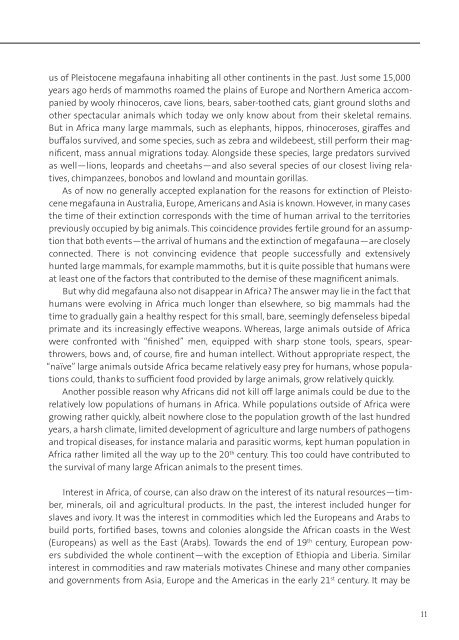Giant_and_Dwarf-FIN
Giant_and_Dwarf-FIN
Giant_and_Dwarf-FIN
Create successful ePaper yourself
Turn your PDF publications into a flip-book with our unique Google optimized e-Paper software.
us of Pleistocene megafauna inhabiting all other continents in the past. Just some 15,000years ago herds of mammoths roamed the plains of Europe <strong>and</strong> Northern America accompaniedby wooly rhinoceros, cave lions, bears, saber-toothed cats, giant ground sloths <strong>and</strong>other spectacular animals which today we only know about from their skeletal remains.But in Africa many large mammals, such as elephants, hippos, rhinoceroses, giraffes <strong>and</strong>buffalos survived, <strong>and</strong> some species, such as zebra <strong>and</strong> wildebeest, still perform their magnificent,mass annual migrations today. Alongside these species, large predators survivedas well—lions, leopards <strong>and</strong> cheetahs—<strong>and</strong> also several species of our closest living relatives,chimpanzees, bonobos <strong>and</strong> lowl<strong>and</strong> <strong>and</strong> mountain gorillas.As of now no generally accepted explanation for the reasons for extinction of Pleistocenemegafauna in Australia, Europe, Americans <strong>and</strong> Asia is known. However, in many casesthe time of their extinction corresponds with the time of human arrival to the territoriespreviously occupied by big animals. This coincidence provides fertile ground for an assumptionthat both events—the arrival of humans <strong>and</strong> the extinction of megafauna—are closelyconnected. There is not convincing evidence that people successfully <strong>and</strong> extensivelyhunted large mammals, for example mammoths, but it is quite possible that humans wereat least one of the factors that contributed to the demise of these magnificent animals.But why did megafauna also not disappear in Africa? The answer may lie in the fact thathumans were evolving in Africa much longer than elsewhere, so big mammals had thetime to gradually gain a healthy respect for this small, bare, seemingly defenseless bipedalprimate <strong>and</strong> its increasingly effective weapons. Whereas, large animals outside of Africawere confronted with “finished” men, equipped with sharp stone tools, spears, spearthrowers,bows <strong>and</strong>, of course, fire <strong>and</strong> human intellect. Without appropriate respect, the“naïve” large animals outside Africa became relatively easy prey for humans, whose populationscould, thanks to sufficient food provided by large animals, grow relatively quickly.Another possible reason why Africans did not kill off large animals could be due to therelatively low populations of humans in Africa. While populations outside of Africa weregrowing rather quickly, albeit nowhere close to the population growth of the last hundredyears, a harsh climate, limited development of agriculture <strong>and</strong> large numbers of pathogens<strong>and</strong> tropical diseases, for instance malaria <strong>and</strong> parasitic worms, kept human population inAfrica rather limited all the way up to the 20 th century. This too could have contributed tothe survival of many large African animals to the present times.Interest in Africa, of course, can also draw on the interest of its natural resources—timber,minerals, oil <strong>and</strong> agricultural products. In the past, the interest included hunger forslaves <strong>and</strong> ivory. It was the interest in commodities which led the Europeans <strong>and</strong> Arabs tobuild ports, fortified bases, towns <strong>and</strong> colonies alongside the African coasts in the West(Europeans) as well as the East (Arabs). Towards the end of 19 th century, European powerssubdivided the whole continent—with the exception of Ethiopia <strong>and</strong> Liberia. Similarinterest in commodities <strong>and</strong> raw materials motivates Chinese <strong>and</strong> many other companies<strong>and</strong> governments from Asia, Europe <strong>and</strong> the Americas in the early 21 st century. It may be11


